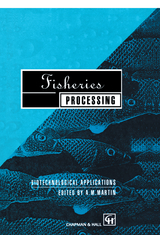Fisheries Processing
Chapman and Hall (Verlag)
978-0-412-58460-2 (ISBN)
One Processing Quality Control.- 1 Microbiological quality of fishery products.- 2 Rapid methods and automation for seafood microbiology.- 3 Microbiological control for fish smoking operations.- 4 New packaging technology for seafood preservation — shelf-life extension and pathogen control.- Two Fisheries Biomass Bioconversion.- 5 Traditional fermented fish: fish sauce production.- 6 Proteases from aquatic organisms and their uses in the seafood industry.- 7 Bioprocessing of chitin and chitosan.- 8 Applications of crustacean wastes in biotechnology.- 9 Production of fish protein concentrates.- 10 Production of fish protein hydrolyzates by microorganisms.- 11 Production of fish silage.- 12 Lactic acid and propionic acid fermentations of fish hydrolyzates.- 13 Mussel processing wastes as a fermentation substrat.- 14 Waste water treatment for fisheries operations.- Three Aquaculture Applications.- 15 Microbial biomass as a source of protein in the feeding of cultivated fish.- 16 Coloring of salmonids in aquaculture: the yeast Phaffia rhodozyma as a source of astaxanthin.- 17 Fish vaccines: development, production and use of bacterial vaccines, with special reference to salmon.
| Erscheint lt. Verlag | 31.5.1999 |
|---|---|
| Zusatzinfo | XV, 494 p. |
| Verlagsort | London |
| Sprache | englisch |
| Maße | 155 x 235 mm |
| Themenwelt | Technik ► Lebensmitteltechnologie |
| ISBN-10 | 0-412-58460-3 / 0412584603 |
| ISBN-13 | 978-0-412-58460-2 / 9780412584602 |
| Zustand | Neuware |
| Haben Sie eine Frage zum Produkt? |
aus dem Bereich




